#and even if not everybody in their fan base is biblically literate
Explore tagged Tumblr posts
Text
okay but the thing is, the Prodigal Son should never have left his father. His father was good and right and cared for him. The Prodigal wished his father was dead and had to hit rock bottom before he decided to come beg for mercy from his father. And the father was merciful and excited and rejoiced that his loser son came home.
it’s an awesome story about the Gospel, or about rejoicing with God over sinners who repent, with open arms—
—so if Clancy is returning to DEMA because “prodigal” is supposed to mean he was a traitor to good and loving leaders and now he’s coming back repentant and ready to serve them, that’s dumb. They shouldn’t have been painting the bishops as bad guys, in that case. The father that the prodigal runs from is THE good guy, the right guy, in the parable.
#I got a comment alleging this on one of my posts#and even if not everybody in their fan base is biblically literate#I know that on some level Tyler Joseph is#so this theory can’t be it#unless they’ve completely lost touch#Clancy#bishops#Bible#literacy#biblical#Christianity
15 notes
·
View notes
Photo
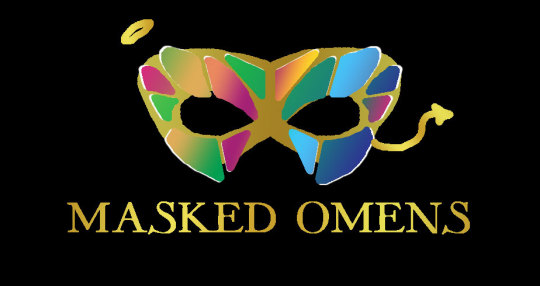
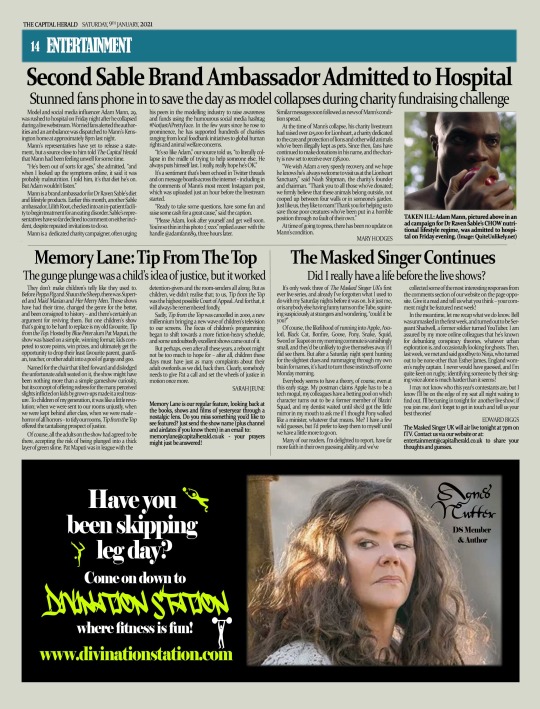
Masked Omens: Week Three
New chapter here, or read from the start here!
(Right click picture and select ‘View Image’ or ‘Open Image In New Tab’ for hi-res version.)
[Image Description: Image 1 - A simple rendition of the Masked Singer UK logo, a golden mask with colourful fragments flying off of it. The mask has a golden halo and a golden devil tail protruding from either side. Below, gold text reads ‘Masked Omens’.
Image 2 - A page from the Entertainment section of the Capital Herald, dated Saturday, 9th January, 2021. Full image description and transcript below the cut. End ID.]
The Capital Herald - Saturday, 9th January, 2021 Entertainment
Main story: SECOND SABLE BRAND AMBASSADOR ADMITTED TO HOSPITAL Stunned fans phone in to save the day as model collapses during charity fundraising challenge Model and social media influencer Adam Mann, 29, was rushed to hospital on Friday night after he collapsed during a live webstream. Worried fans alerted the authorities and an ambulance was dispatched to Mann's Kensington home at approximately 8pm last night. Mann's representatives have yet to release a statement, but a source close to him told The Capital Herald that Mann had been feeling unwell for some time. “He's been out of sorts for ages,” she admitted, “and when I looked up the symptoms online, it said it was probably malnutrition. I told him, it's that diet he's on. But Adam wouldn't listen.” Mann is a brand ambassador for Dr Raven Sable's diet and lifestyle products. Earlier this month, another Sable ambassador, Lilith Root, checked into an in-patient facility to begin treatment for an eating disorder. Sable's representatives have so far declined to comment on either incident, despite repeated invitations to do so. Mann is a dedicated charity campaigner, often urging his peers in the modelling industry to raise awareness and funds using the wry social media hashtag #NotJustAPrettyFace. In the few years since he rose to prominence, he has supported hundreds of charities ranging from local foodbank initiatives to global human rights and animal welfare concerns. “It‘s so like Adam,” our source told us, “to literally collapse in the middle of trying to help someone else. He always puts himself last. I really, really hope he’s OK.” It’s a sentiment that’s been echoed in Twitter threads and on message boards across the internet - including in the comments of Mann’s most recent Instagram post, which was uploaded just an hour before the livestream started. “Ready to take some questions, have some fun and raise some cash for a great cause,” said the caption. “Please Adam, look after yourself and get well soon. You’re so thin in this photo :( xxxx” replied a user with the handle @adamfann95, three hours later. Similar messages soon followed as news of Mann’s condition spread. At the time of Mann’s collapse, his charity livestream had raised over £15,000 for Lionheart, a charity dedicated to the care and protection of lions and other wild animals who’ve been illegally kept as pets. Since then, fans have continued to make donations in his name, and the charity is now set to receive over £38,000. “We wish Adam a very speedy recovery, and we hope he knows he’s always welcome to visit us at the Lionheart Sanctuary,” said Noah Shipman, the charity’s founder and chairman. “Thank you to all those who’ve donated; we firmly believe that these animals belong outside, not cooped up between four walls or in someone’s garden. Just like us, they like to roam! Thank you for helping us to save those poor creatures who’ve been put in a horrible position through no fault of their own.” At time of writing, there has been no update on Mann’s condition. MARY HODGES. [Image Description: a close-up of biblical Adam biting the apple, taken from the Good Omens TV show. End ID.] TAKEN ILL: Adam Mann, pictured above in an ad campaign for Dr Raven Sable’s CHOW nutritional lifestyle regime, was admitted to hospital on Friday evening (Image: QuiteUnlikely.net)
Centre left: Memory Lane: Tip from the Top The gunge plunge was a child's idea of justice, but it worked. They don't make children's telly like they used to. Before Peppa Pig and Shaun the Sheep, there was Superted and Maid Marian and Her Merry Men. Those shows have had their time, changed the genre for the better, and been consigned to history – and there's certainly an argument for reviving them. But one children's show that's going to be hard to replace is my old favourite, Tip from the Top. Hosted by Blue Peter alum Pat Maputi, the show was based on a simple, winning format; kids competed to score points, win prizes, and ultimately get the opportunity to drop their least favourite parent, guardian, teacher, or other adult into a pool of gunge and goo. Named for the chair that tilted forward and dislodged the unfortunate adult seated on it, the show might have been nothing more than a simple gameshow curiosity, but its concept of offering redress for the many perceived slights inflicted on kids by grown-ups made it a real treasure. To children of my generation, it was like a little revolution; when we were sent to our rooms unjustly, when we were kept behind after class, when we were made – horror of all horrors – to tidy our rooms, Tip from the Top offered the tantalising prospect of justice. Of course, all the adults on the show had agreed to be there, accepting the risk of being plunged into a thick layer of green slime. Pat Maputi was in league with the detention-givers and the room-senders all along. But as children, we didn't realise that; to us, Tip from the Top was the highest possible Court of Appeal. And for that, it will always be remembered fondly. Sadly, Tip from the Top was cancelled in 2000, a new millennium bringing a new wave of children's television to our screens. The focus of children’s programming began to shift towards a more fiction-heavy schedule, and some undoubtedly excellent shows came out of it. But perhaps, even after all these years, a reboot might not be too much to hope for – after all, children these days must have just as many complaints about their adult overlords as we did, back then. Clearly, somebody needs to give Pat a call and set the wheels of justice in motion once more. SARAH JEUNE. Memory Lane is our regular feature, looking back at the books, shows and films of yesteryear through a nostalgic lens. Do you miss something you’d like to see featured? Just send the show name (plus channel and airdates if you know them) in an email to: [email protected] - your prayers might just be answered!
Centre right: The Masked Singer Continues Did I really have a life before the live shows? It's only week three of The Masked Singer UK's first ever live series, and already I've forgotten what I used to do with my Saturday nights before it was on. Is it just me, or is anybody else having funny turns on the Tube, squinting suspiciously at strangers and wondering, “could it be you?” Of course, the likelihood of running into Apple, Axolotl, Black Cat, Bonfire, Goose, Pony, Snake, Squid, Sword or Teapot on my morning commute is vanishingly small, and they'd be unlikely to give themselves away if I did see them. But after a Saturday night spent hunting for the slightest clues and rummaging through my own brain for names, it's hard to turn those instincts off come Monday morning. Everybody seems to have a theory, of course, even at this early stage. My postman claims Apple has to be a tech mogul, my colleagues have a betting pool on which character turns out to be a former member of Blazin' Squad, and my dentist waited until she'd got the little mirror in my mouth to ask me if I thought Pony walked like a minister, whatever that means. Me? I have a few wild guesses, but I'd prefer to keep them to myself until we have a little more to go on. Many of our readers, I'm delighted to report, have far more faith in their own guessing ability, and we've collected some of the most interesting responses from the comments section of our website on the page opposite. Give it a read and tell us what you think – your comment might be featured next week! In the meantime, let me recap what we do know. Bell was unmasked in the first week, and turned out to be Sergeant Shadwell, a former soldier turned YouTuber. I am assured by my more online colleagues that he's known for debunking conspiracy theories, whatever urban exploration is, and occasionally looking for ghosts. Then, last week, we met and said goodbye to Ninja, who turned out to be none other than Esther James, England women's rugby captain. I never would have guessed, and I'm quite keen on rugby; identifying someone by their singing voice alone is much harder than it seems! I may not know who this year's contestants are, but I know I'll be on the edge of my seat all night waiting to find out. I'll be tuning in tonight for another live show; if you join me, don't forget to get in touch and tell us your best theories! EDWARD BIGGS. The Masked Singer UK will air live tonight at 7pm on ITV. Contact us via our website or at: [email protected] to share your thoughts and guesses. Ad (bottom third of the page): [Image Description: A banner ad with a black background. On the right is a photograph of Agnes Nutter as seen in Good Omens, demonstrating some serious side-eye. Overlaid is Agnes Nutter’s signature, followed by the words ‘DS member & Author’. On the left, bright yellow-green figures demonstrating various exercises - a football goalie making a save, a gymnast balancing on their hands, and a weightlifter - surround the main text. End ID.] Have you been skipping leg day? Come on down to DIVINATION STATION [the words ‘Divination Station’ are a graffiti-style logo] where fitness is fun! www.divinationstation.com
#disordered eating tw#eating disorder tw#masked omens#masked omens spoiler#mine#good omens fic#mo week three
0 notes
Text
First up on the agenda in Melbourne: The Immigration Museum. Melbourne has loads of really cool museum, but this was the one I was most excited about. It tells the story of how Melbourne came to be the multicultural gem that it is today by sharing the personal stories and experiences of the immigrants themselves.
Like May Vale, for example, whose parents were English migrants. Vale was one of Australia’s first female professional artists. Over the years, she went back and forth between London and Melbourne, but ultimately, she said, “I know my London well. I have lived there in all over ten years. But, as you see, I always return to Melbourne.”
In Melbourne, she was a founder and councillor of the Yarra Scultpors’ Society, as well as the councillor of the Victorian Artists Society.
Then there’s the Azzola family from Italy. The husband and wife sailed to Melbourne and made a life for themselves here that they never could have afforded back home. Edda Azzola even went on to become a big name in the fashion industry here.
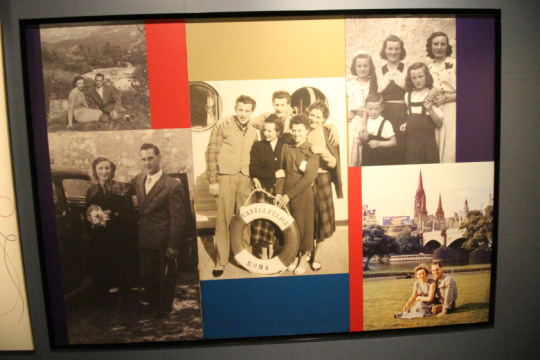
Youssef came over from Lebanon with his family and started a successful taxi company with his brother.

In 2009, Nickel and Gertrude had their refugee claim accepted. After a harrowing several years trying to escape the DRC, they finally made a safe and happy life for themselves in Melbourne.
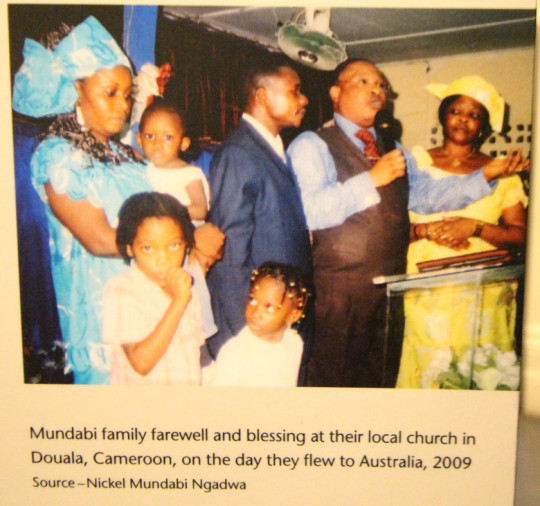
John Christie came over from Scotland back in 1863 and went on to become a badass detective. He would go undercover using various disguises to nab the bad guys. However, like much of Australia back in the day, he had a big racist streak to him. Just as the “War on Drugs” today targets African Americans, Christie went on a conquest to target opium smugglers to ramp up anti-Chinese racism–this, even though opium was totally legal in Australia, was sold over the counter, and was an important part of government revenue thanks t customs taxes.
I love that this place is so proud of its immigrant history that it has dedicated an entire museum to immigration. Sure, not all of its history is pretty, but this museum acknowledges that there would be no Australia without immigrants, and that’s a pretty big deal. They are an integral part of the nation’s DNA. Those nationalist iditos at the White House and the fools behind Brexit could learn a thing or two from Australia.
Oh wait, the English are the ones who sent their hardened “criminals” here in the first place. (More often than not, their crimes were very minor, like stealing a loaf of bread.) The first batch was brought over to New South Wales in 1788. And the only reason they did so was because after losing the United States, they figured they should colonize Australia before Japan could sink their hands into it.
One legendary convict was William Buckley. He managed to escape, and was thought to be dead. Officers figured he couldn’t last out in the wild on his own. He ended up taking shelter among the Wathaurong people for just over 30 years. He found a walking stick that had belonged to one of their elders. When they found him in possession of the stick, they believed him to be the reincarnation of their elder. He ran with this for over thirty years. Good for him.
Another white man that duped the Aboriginals was John Batman. Batman signed a treaty with Aboriginals in the Port Phillip area and gained 250, 000 hectares of land for things like utensils and blankets. Government officials in Sydney declared this treaty invalid, since Batman didn’t have the legal rights to make such a deal. He ended up getting a pretty sweet land deal later on though. As usual, white man prevails.
In the end, Australia almost ended up being called Batmania. And while that is an AWESOME name, I’m glad they didn’t go with it. Batman seems like he was a dick.
Not only does the museum tell the personal story of migrants, though; it also tells the overall story of Australia’s growth as a country. For example, at the start of the 1850s, Victoria was declared a separate colony JUST before gold is discovered in Melbourne, leaving Sydney out in the cold. They also started charging a tax for Chinese immigrants AND they stopped bringing in immigrants from England. Victoria be ruthless.
Thankfully, they came to their senses the following decade. Anti-Chinese legislation was repealed, and Australia quit the “civilise and Christianise” game with Aborigines.
The origins of Chinese immigration to Australia is pretty tragic. They started coming over as cheap labour during the gold rush after England stopped sending over convicts in 1840.
Few were able to pay for their own voyage. Instead, village elders and families took out loans through shipping agents because they believed these young men would be raking in the dough once they got to Australia and that they’d be able to pay off their loans in no time. The men believed they’d be able to come back with enough money to build temples, homes, and schools for their villages. The truth was that they were getting exploited. The only way they could pay back the loan was through gold or labour. If they couldn’t pay back the loan, their families could be sold off as labourers as well.
The reaction by locals was pretty predictable. To quote South Park: “Dey tuk ar jarbs!” There were riots, and the government ended up limiting the number of Chinese migrants allowed into the country. And to avoid hefty head taxes at the Victorian ports, ships ended up dropping migrants off in southern Australia, leaving them to hike brutal 700 km to the gold fields. Those who couldn’t afford to pay the one pound tax were literally thrown into the water with their belongings.
Even among the Chinese immigrants themselves there was division, as there were conflicts between certain ethnic groups.
Those who fell ill during the voyage were treated by volunteers, since the Australian government didn’t want to spend money on the Chinese workers.
In the end these brave young men achieved varying level of success. Some returned home very prosperous; others never returned home because they couldn’t afford the return passage; some married European women and made a life for themselves in Australia.
But then China got put back on Australia’s bad books in the 80s, and Chinese immigration was put on lock down.

By the 90s, the gold rush has come and gone, and an economic depression hits. And where does the blame go? The immigrants, of course. One particular policy is passed that allows companies to be inspected to see if they employ Chinese workers. Any furniture made by Chinese hands must be stamped to indicate so.
Things became even worse after Federation in 1901. A national dictation test was introduced to make it difficult for non-British immigrants to migrate over. For example, a Greek person could be given the test in Gaelic. If they failed, they couldn’t enter the country.

Over the years, the racially-charged politics and policies have come and gone and come and gone again. I mean, fast forward, and there has been some level of anti-immigration rhetoric floating around since the mid-1980s. It’s gained momentum over the years, though. The One Nation party, which is proudly anti-Islam and anti-multiculturalism in general, won 4 Senate seats in 2016.

There is also some sort of offshore camp where unauthorized immigrants and refugees are indefinitely held in limbo on the islands of Nauru and Manus. Most of these asylum seekers are from the Middle East and Africa.
However, this is not how all Australians feel. Multiculturalism is embraced and welcomed here. Australia celebrates the food, heritage, and culture of all of its people.
Apparently in 2016, the US and Australia made a deal in which the US would take 1200 of Australia’s refugees, while Australia would take asylum seekers who were looking for a new home in the US. Most of these were from Central America. Not sure what the point is there. A refugee is a refugee no matter where they come from.
One of my favourite features in the museum was an interactive activity. You acted as an immigration officer and had to decide whether a family or applicant would have been approved or declined back in the day based on answers they gave in a video interview. The one I saw featured a jolly Greek man, his wife who spoke no English and kept rambling on and pleading with the officer, and their little daughter. It was really well done.
The last place I checked out before leaving this inspiring place was an exhibit that looked at the complexities of the immigrant identity–your name, your looks, the first impression you leave on others, etc.
There were some fantastic quotes from individuals that I could relate to on varying levels:
“As an adolescent growing up, my name caused me great embarrassment and I hated anything that was Asian. How I wished to be Mary Smith.”
Story of my life. As my friends and family know, I hated that bitch of a Disney mermaid growing up because of the similarity between our names. Kids can be so cruel…
It wasn’t until I got older and I learned that my name translates to Angel of Light that I came to appreciate my name. But even so, it’s a Biblical name, and I’m not really the biggest fan of the Bible and religion in general for reasons that I don’t feel like going into at this very moment. So there’s this uncomfortable connection between me and the very thing that makes me ME–my name.
I think that’s probably why I prefer to go by Uri. Well, that, and I eventually got tired of people butchering my name. But even Uri technically isn’t really accurate–at least, not the way most people pronounce it. In Spanish, my name is pronounced Oo-ree-el, meaning that the shortened version should be pronounced Oo-ree–but everybody outside of my family and our awesome neighbours calls me Yuri.
I’ll admit that this is my own fault. When I first decided to go by the shortened version, which is what my mother has always called me, Oo-ree sounded a bit goofy to me–at least, when it came out of anybody’s mouth except my family’s. I was embarrassed by how it sounded. So I gave it a Eurocentric twist and changed it to Yuri. It made sense because people always pronounced my full name Yuriel anyway. Now I’m 33 years old, and I feel like it’s a bit late to start asking everybody to call me Oo-ree.
Agh! It’s so complicated!
“I looked quite normal, I sounded like everyone else, but I had a surname which no one could ever pronounce.”
Nobody in school ever looked like me. I could name all of the Spanish speaking people I ever went to school with all the way back to Kindergarten. Grade 2: Monica and Javier. Grade 6: Isaac and Luis. Grade 9: Oscar. University: Betsabe. That’s the whole reason I decided to stop speaking Spanish once I started school–if I couldn’t look like everybody else, I at least wanted to sound like everybody else.
“I’m Joanita Da Silva or Joanita Barbosa Muniz Da Silva in full. My full name includes my god-father’s family name, my mother’s family name, and my father’s family name.”
I’m Uriel Eduardo Mendoza Ulloa. My full name includes my father’s first name and family name and my mother’s family name.
“When I look in the mirror I don’t see what other people see. I’m just Sherene. But when I meet people for the first time, they look at me differently–and the questions begin.”
This one I’m okay with. I like being asked where I’m from. I like sharing my family’s story. I’m proud of our journey and my own personal journey of acceptance of my cultural identity. I’m a proud Nicaraguan Canadian with Nicaraguan blood and a Canadian heart. In the future, as immigrant cultures mix more and more, these stories are going to become more and more complex and more and more beautiful. I think the questions are the spark to a powerful conversation.
“Even if I claim Australian citizenship people will insist on my being Chinese unless I can rip this face of its Chinese skin and replace it with something else, anything else but Chinese. Physically, though, I can’t.”
“‘But you don’t look like a Muslum’ would be the most common response. Do I look like a Christian then? Are we supposed to look our religion? I prefer to look like myself.”
These two are connected as far as I’m concerned. I was once asked by a guy in Korea where I was from. When I told him I was from Canada, he gave me a puzzled look and said, “But you don’t look Canadian.” So in his mind, a Canadian must be white. This one still irks me. Like I said, I’m proud of my Canadian-ness, so it hurts if somebody accuses me of not being “Canadian” enough. There’s no such thing as a typical Canadian.
Okay, tired of the Immigration Museum? Let’s move on to the Australian Centre for the Moving Image, otherwise known as the ACMI Museum. It tells the story of the moving image, from a slide projector in the 17th century to video games like Minecraft and Super Mario Brothers today.
In the mid-17th century, a Jesuit priest by the name of Athanasius Kircher was one of the first to use a slide projector called the Magic Lantern. He used it to project religious and supernatural scenes.
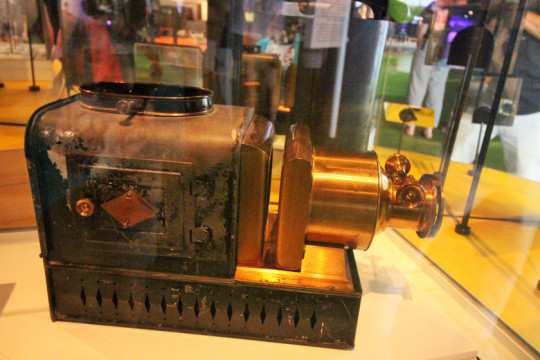
A century later, entertainers used it to project images of things like severed heads and spirits floating in smoke. These shows were called phantasmagoria.
Apparently France was quite fond of puppet shows like this one in the 19th century.

Remember when you were a kid and you’d make a little flipbook animation scene? That’s basically what this does. This one is from Belgium in the 19th century.
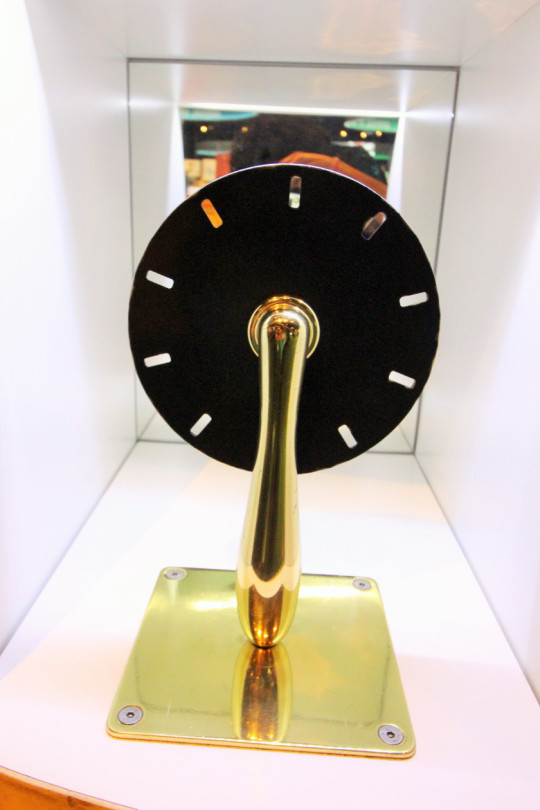
On December 28, 1895, 33 viewers were treated to the first moving image shown in a popular cafe in Paris. Imagine seeing a moving image onscreen for the first time. The closest I can think of to that experience would be the first time I saw the Matrix in theatres. My mind was still in shock the entire drive home, trying to make sense of what it had just seen. Talk about a game changer!
The Story of the Kelly Gang is arguably one of the first feature length films ever made. In 1906, most films ran about 12 minutes long. This film ran over an hour. It was obviously a huge gamble on the part of the movie studio, but it paid off. It cost them 1000 pounds, and earned them a whopping 25000 pounds. This marked the beginning of a huge film boom in Australia. The movie tells of the notorious Kelly Gang outlaws of Australia. Ned Kelly was Australia’s Robin Hood. They came under fire when they killed a few officers though.
I had no idea that Felix the Cat was Australian! He was invented by an Australian chap named Pat Sullivan in 1917.

The Golden Age of Hollywood ran until the late 1940s. This period was marked with big movie star names, huge productions, and lavish sets.
Religion had to come in and ruin all of the fun, though, by pressuring Hollywood to clean up its act in the early 30s. First, studios agreed to adopt a set of rules that stated:
The more intimate parts of the human body are the male and female organs and the breasts of a woman. – They should never be uncovered. – They should not be covered with transparent or translucent material. – They should not be clearly and unmistakably outlined by the garment.”
While these rules were not really adhered to at first, by 1934, the Catholic Legion of Decency (REALLY?) forced Hollywood to adopt what we now know as the MPAA rating system.
Two things brought about the end of this magical period. One was the Paramount Decree. In 1948, the Supreme Court ruled that the movie studios had too much control of the industry because they could produce and promote their own movies in their own cinema houses, so they had to sell off these cinemas.

The other development was the invention of the television. Television arrived in Australia in 1956, just in time for the Olympics. But it only arrived in Melbourne and Sydney, since only they had stations. Places further out didn’t get television until much later. For example, it didn’t arrive in Darwin until 1971. 1971! That’s only six years before the first Star Wars was released! And speaking of Star Wars…

This is art.
But back to cinema for a second.
Cinemas in Australia weren’t desegregated until 1967, thanks in large part to Indigenous activist groups like the Freedom Riders, who bought tickets to the whites-only section in protest. Their refusal into the cinema and subsequent arrests were broadcasted on news channels around the country.
The ladies in Australia have also been holding it down since the 70s. The Women’s Movement was a grassroots effort that addressed issues like harassment and unequal pay by making films to raise awareness and spark discussions. (How is it that almost half a decade on, these problems still persist?)
This led to the Sydney Women’s Film Group, which produced, distributed, and exhibited women’s films throughout the 70s and 80s. They also lobbied the government for funding and training for female filmmakers. This eventually all led to the establishment of the Women’s Film Fund.
Pretty awesome, Australia!
The rest of the exhibit talked about the introduction of things like colour TV, the VCR, video games, and the digital age.

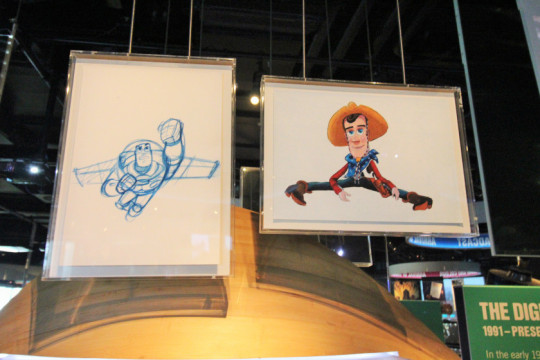
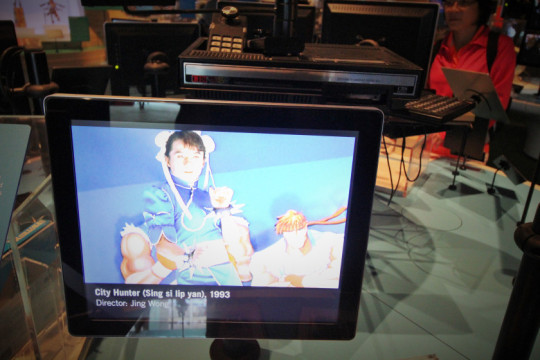
Yes, that is Jackie Chan dressed as Chun Li. Why I have never seen this movie, I have no idea.
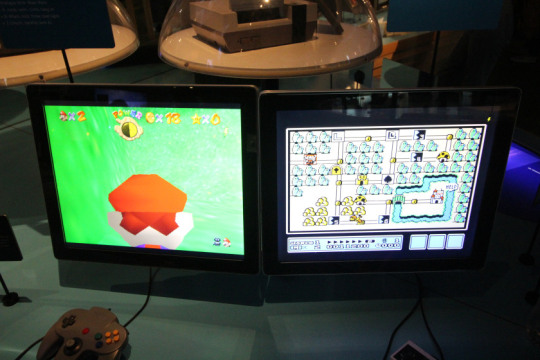
Sadly, we missed the Alice in Wonderland exhibit by a month. It’ll be opening next month.

We left the museum just in time to meet up with Josue, a guy I met in Egypt a couple years ago. He’s now living in Melbourne at the moment. We met up for lunch and walked around downtown Melbourne for a while, catching up on the last two years.
Our walk ended back at Federation Square where we had met. We asked a woman if she wouldn’t mind taking our picture. She seemed confused by this request. “Why?” she asked.
We were confused by HER question. “Because we want a picture together…?”
“Alright. Let me put my hoodie up first.”
“……….?”
She then posed really awkwardly and uncomfortably, waiting for the shot.
“No, no, no, no, no! We want YOU to take OUR picture!”
*Everybody laughs*
And this is the crappy picture that resulted.
Overall, though, not a bad first day of exploring Melbourne. Tomorrow’s adventure would include a free walking tour.
The Travelling Trooper Explores A Couple Of Melbourne’s Many Museums First up on the agenda in Melbourne: The Immigration Museum. Melbourne has loads of really cool museum, but this was the one I was most excited about.
#acmi museum#Around the world#australia#federation square#immigrants#immigration#immigration museum#melbourne#Travelblog
0 notes
Photo










Old Crow Medicine Show at Express Live!, Columbus, Ohio, May 31, 2017
A familiar drumbeat emanated from the backstage area…
After a few seconds of pounding, Old Crow Medicine Show emerged from the wings and began parading across the outdoor stage of Columbus’ Express Live!, bringing with them bass and snare drums, squeezebox, harp and other implements of musical construction and launching simultaneously into “Rainy Day Women #12 & 35” and their Wednesday night performance of Bob Dylan’s 1966 double LP, Blonde on Blonde.
The audience sang along boisterously on the chorus - everybody must get stoned! And judging by the smell of things, many didn’t understand the track is more biblical allegory than invitation to fire up.
Though it’s been 51 years since Dylan released the seminal album, Old Crow - perhaps they, too mistook the sage’s sage advice and got high - are playing the classic record every night as they crisscross the country on their 50 Years of Blonde on Blonde tour. And they play the hell out of it, as the six Medicine men, augmented by two auxiliary musicians, render Dylan’s 14 folk/rock tracks in a bluegrass fashion and spread the fun over two sets of 40 and 60 minutes, respectively.
The group’s various vocalists resisted the temptation to ape Dylan, instead brining their own styles to the songs. And, the virtuoso band members switched instruments as often as Dylan’s changed styles over the years.
Three Old Crows took a seat behind the drum kit over the course of the evening; frontman and main singer Ketch Secor played harmonica, fiddle, guitar, mandolin and banjo, while Critter Fuqua - who did a hilarious impression of a mysterious, hoodie-wearing Dylan as Secor talked about meeting the man a few years back - chipped in on drums, banjo and guitar. Pedal steel, guitjo, piano and organ, standup bass and Dobro - even some fleet-footed tap-shoeing from Kevin Hayes, who brought his song-and-dance routine to the front of the stage for a rip-snortin’ rendition of “Leopard-Skin Pill-Box Hat” - were part of the medicinal mix.
Secor spent the entire show dancing, prancing and generally playing like a madman. He paused early on to praise Dylan’s album - which they recently remade as the live LP 50 Years of Blonde on Blonde (again ignoring basic math) - and seemed genuinely honored to be revisiting the “Book of Bob." He pointed out that Blonde was popular music’s first double album and reminded fans that Dylan opened the door for musicians across the spectrum to use Nashville as a base for recording more than just country music.
While Secor’s enthusiasm was infectious, he was also overbearing at points. He made literally dozens of references to Ohio, O-H-Ten, Columbus, Franklin County or some nearby suburb throughout the evening - so many that even the city’s director of tourism would have told him, “Enough!” Cheese-ball jokes - such as if Dylan had been from central Ohio, he would’ve named track No. 3 “Visions of Gahanna” - elicited groans.
Somewhere, Johanna wept.
But wading through the insipid stage banter was worth it to hear Old Crow Medicine Show’s inspired take on Blonde on Blonde. In their 16 capable hands, “One of Us Must Know (Sooner or Later)” and “Just Like a Woman” were more homages than reinterpretations; “Stuck Inside of Mobile with the Memphis Blues Again” struck an entirely new tone as OCMS added a bit of hillbilly shine to its decades-old patina; and “Obviously Five Believers,” though rendered on acoustic instruments, was every bit as electric as the original.
Old Crow Medicine Show closed the second set - as Dylan closed his album - with “Sad-Eyed Lady of the Lowlands.” The track took up all of Side 4 in 1966, but took up only about 10 minutes in 2017 and included band introductions.
The sextet-cum-octet continued the Dylanesque mood during the encore, as the six main Medicine men gathered around a single mic for a sublime reading of “Knockin’ on Heaven’s Door,” followed by an angry, true-to-the-original rendition of “Like a Rolling Stone.”
The inevitable “Wagon Wheel,” an OCMS-Dylan collab across several decades, followed, before the band tipped their collective cowboy hats to the late, “great and legendary” Gregg Allman, who died May 27, as Cory Younts on organ and lead vocals, led his bandmates through a faithful remake of “Midnight Rider.”
“We love you, Gregg!,” Secor shouted as the song and the concert came to a close. And in that moment, all his other banter was forgiven.
Grade card: Old Crow Medicine Show at Express Live! Pavilion - 5/31/17 - A
#old crow medicine show#ketch secor#critter fuqua#kevin hayes#morgan jahnig#chance mccoy#cory younts#bob dylan#blonde on blonde#50 years of blonde on blonde#gregg allman#the allman brothers band
0 notes